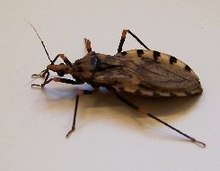一氧化氮生物化學效用
一氧化氮,化學式為NO,是雙原子化合物分子。在許多哺乳動物(包括人類)體內,一氧化氮都作為一種信號分子(氣態信號分子)參與到許多生理和病理過程中。 [1]一氧化氮在血液中還是一種強效血管擴張劑,其半衰期只有幾秒鐘。許多量產的經典藥物(如硝化甘油和亞硝酸異戊酯)就是一氧化氮的緩釋前體。肝臟中發生的缺血性損傷往往導致哺乳動物體內一氧化氮水平降低。1992年,一氧化氮因為它在神經科學、生理學和免疫學等學科的重要性而獲評《科學》雜誌「年度分子」。[2]1998年,因發現一氧化氮在心血管系統中起信號分子作用,羅伯·佛契哥特、費瑞·慕拉德和路易斯·伊格那羅共同獲得了當年的諾貝爾生理學或醫學獎。
一氧化氮的來源
[編輯]一氧化氮的生物合成
[編輯]一氧化氮在生物體內可由剪切力、血小板衍生生長因子、乙醯膽鹼、細胞因子等刺激內皮型一氧化氮合酶(eNOS)產生。eNOS通過氧化L-精胺酸末端的胍基得到一氧化氮,同時產生了副產物瓜胺酸。上述過程依賴著鈣-鈣調蛋白和其他輔助因子。
生物體內的一氧化氮亞穩定自由基由一氧化氮合酶(NOSs)產生。已知該酶存在三種同工酶,分別是內皮型(eNOS)、神經型(nNOS)和誘導型(iNOS),每種同工酶都具有不同的特色。神經型和內皮型是鈣依賴的,並且單個細胞產生的一氧化氮信號分子水平較低。而誘導型並不依賴鈣,能產生高水平的一氧化氮,甚至會產生毒副作用。[3][4]
外源一氧化氮藥物
[編輯]
當生物體內無法正常產生足量所需的一氧化氮時, 一氧化氮緩釋藥物可以有效地補充一氧化氮。[5]生物體內某些內源型化合物也有提供一氧化氮的能力。硝化甘油和亞硝酸異戊酯可以在體內分解產生一氧化氮,所以醫學上被廣泛當作血管擴張劑。又如血管舒張型降壓藥米諾地爾中也含有類似一氧化氮的結構,亦可以起到一氧化氮的效果。更為人熟知的還有治療男性勃起功能障礙的藥物西地那非(中國大陸註冊名萬艾可,台灣和港澳商品名威而鋼),藥物分子中類似一氧化氮的結構可以透過增強一氧化氮信號通路達到刺激勃起的目的。[6][7]
自然途徑
[編輯]飲食中的硝酸鹽是哺乳動物體內一氧化氮的重要來源。綠色多葉蔬菜和一些根類蔬菜(例如甜菜根)中含有較多的硝酸鹽。[8]哺乳動物攝入這些食物時,經過舌頭表面共生的兼性厭氧細菌的作用,亞硝酸鹽會在唾液中濃縮約10倍。[9]吞咽下後,亞硝酸鹽與胃中的酸和還原性物質(如抗壞血酸鹽)反應生成較高濃度的一氧化氮。這種機制被認為是對吞咽食物的一種滅菌,並維持胃黏膜血管擴張性。[10]
汗液中含有的硝酸鹽可在微酸性環境和皮膚表面共生菌作用下經亞硝酸鹽還原為一氧化氮,或者亞硝酸鹽在陽光下發生紫外線光解生成一氧化氮。這種機制被認為是一種保護皮膚免受真菌感染的方式,可能引起人體全身血液循環變化,因此也被應用於醫療手段中。[11]
研究表明,不同於口呼吸,鼻呼吸可以在體內產生一氧化氮。[12][13][14][15]
相關免疫反應
[編輯]
一氧化氮可由吞噬細胞(包括單核細胞、巨噬細胞和中性粒細胞)產生,繼而參與到人體免疫反應中。[17]吞噬細胞中通常含有誘導型一氧化氮合成酶(iNOS),該酶可由干擾素-γ單一信號或由腫瘤壞死因子-α和第二信號激活。[18][19][20]相反的,轉化生長因子-β可對該酶產生強烈的抑制作用,白血球介素-4和白血球介素-10則可起到較微弱的抑制作用。通過這些信號分子對誘導型一氧化氮合成酶活性的調節作用,免疫系統便可調節吞噬細胞在炎症和免疫反應中產生一氧化氮的水平。[21]而一氧化氮作為一種自由基,可以導致DNA損傷以及蛋白質鐵硫中心的降解,對入侵的細菌和胞內寄生蟲(包括利什曼原蟲和瘧原蟲)起到殺傷作用,如此便參與到了免疫反應中。[22][23][24][25][26][27][28][29]
吞噬細胞通過iNOS的誘導途徑可以一次性生成大量的NO引發細胞凋亡而殺死其他細胞。體外研究表明,吞噬細胞獨立產生的NO濃度大於400至500nM時便會引發臨近細胞的細胞凋亡,這與SPM通過中和並加速清除炎症組織的促炎細胞來起到抑制、扭轉炎症反應的方式類似。[30]然而,NO自由基在炎症反應中扮演的角色仍是一個複雜課題,一些模式化的研究(包括病毒感染)表明NO也可能使炎症惡化。[31]許多細菌性病原體已經進化出了一氧化氮抗性機制來抵抗它的殺滅作用。[32]
因為NO可以在哮喘等病症的檢測上作為炎症程度的度量物質,所以基於NO的呼氣測試的炎症檢測設備研發工作愈發熱門。呼出NO濃度水平的下降有時可歸因於空氣污染或吸菸,但總體而言,空氣污染的影響更大。[33]
NO對生物大分子的影響
[編輯]一氧化氮在細胞中主要涉及兩大類反應,其一為硫醇的S-亞硝基化,其二為酶金屬核心的亞硝基化。
硫醇的S-亞硝基化
[編輯]S-亞硝基化包含巰基的可逆反應,含有半胱胺酸殘基的蛋白質都有可能發生此類反應生成亞硝基硫醇(RSNOs)。這是適用於所有類型蛋白質的翻譯後調節機制。[34]
酶金屬核心的亞硝基化
[編輯]
鐵、銅等過渡金屬核心容易和NO反應生成金屬亞硝基錯合物。血紅蛋白發生亞硝基化導致的酶活性喪失便是一個典型例子。亞硝基化亞鐵十分穩定,因此對於亞鐵核心的酶,無論NO自由基的直接絡合還是硫醇S-亞硝基化產物發生的亞硝基轉移都很容易發生。[36]所以諸如含有亞鐵的核糖核苷酸還原酶和順烏頭酸酶都易於被NO滅活。[37]
鳥苷酸環化酶是一種含有血紅素的酶分子,在NO作用下,血紅素發生亞硝基化,環磷鳥苷激活cGMP依賴性蛋白激酶 ,引發鈣離子的再吸收,從而打開鈣離子激活的鉀離子通道,再經過一系列離子濃度調節導致了平滑肌細胞鬆弛。[38]
NO對血管和肌肉的調節
[編輯]一氧化氮可以導致血管舒張,以增加血液供應並降低血壓。因此,一氧化氮可用於保護組織免受缺血損害。[39]一氧化氮也是一類神經遞質,在平滑肌組織中的亞硝酸神經元間起效,常見於消化道組織和勃起組織。[40]一氧化氮通過抑制平滑肌的收縮與生長、血小板聚集以及白血球與內皮細胞的粘附促進血管內環境穩態。動脈粥樣硬化、糖尿病、高血壓患者常常被發現體內一氧化氮表達途徑異常。[41]一氧化氮可通過多種途徑誘導生成,導致多種蛋白質發生磷酸化,繼而導致平滑肌鬆弛。[42]在腎臟細胞外液穩態調節中,一氧化氮對血管舒張的調節起到了關鍵影響。[43]一氧化氮在陰莖和陰蒂的勃起中也起到血流血壓調節作用。[44]一氧化氮作用於心肌組織,可以降低收縮力和心率。
一氧化氮對其他生物的影響
[編輯]植物
[編輯]一氧化氮在植物中有以下四種生成途徑:L-精胺酸依賴性一氧化氮合酶[45][46][47](植物中是否存在動物NOS同源物存在爭議)[48],質膜結合硝酸鹽還原酶,粒線體電子傳遞鏈以及非酶促反應。一氧化氮在植物中作為一種信號分子,主要在抗氧化應激和植物病理學作用等方面起效。研究表明,使用一氧化氮處理切花可以保鮮。[49][50]一氧化氮可以調節某些植物病理學和生理學作用,如植物過敏反應,共生作用(如豆科植物與根瘤菌共生產生根瘤),側根、不定根、根毛的發育,氣孔的開合等。一氧化氮常在細胞器內產生,諸如粒線體、過氧化物酶體和葉綠體都能產生一氧化氮,使之參與到與活性氧發生的抗氧化反應中去。[51]一氧化氮指標可用於N端蛋白質降解、非生物逆境應激(旱澇、鹽鹼脅迫)的表徵。[52][53][54][55]在多種植物激素的信號傳遞途徑中(如生長素、乙烯、脫落酸、細胞分裂素)都已發現了一氧化氮的參與。[54][56][57][52][58]大氣氮循環過程中的一氧化氮可通過氣孔進入到維管植物中,對葉片瘢痕的產生、植物固氮、組織壞死產生影響。[59]
昆蟲
[編輯]
諸如臭蟲、錐蝽之類的吸血昆蟲用一氧化氮來舒張獵物的血管來促進其覓食血液。它們通過唾液中的載體硝化蛋白產生一氧化氮。[35]
細菌
[編輯]
通常一氧化氮抑制細菌生長,並作為一種特性運用於免疫反應中。但是某些情況下一氧化氮可以保護細菌。2009年一報道顯示,抗輻射奇異球菌在經過紫外線輻射損傷後,一個增加一氧化氮表達的基因啟動,促進了DNA修復與細胞生長;而在該基因敲除的情況下,細菌僅能修復DNA而無法生長。[60]
參考資料
[編輯]- ^ Hou, YC; Janczuk, A; Wang, PG. Current trends in the development of nitric oxide donors. Current Pharmaceutical Design. 1999, 5 (6): 417–41. PMID 10390607.
- ^ Culotta, Elizabeth; Koshland, Daniel E. Jr. NO news is good news. Science. 1992, 258 (5090): 1862–1864. Bibcode:1992Sci...258.1862C. PMID 1361684. doi:10.1126/science.1361684.
- ^ Ignarro L.J. (1990): Nitric Oxide. A Novel Signal Transduction Mechanism For Transcellular Communication; Hypertension; 16(5): 477-483.
- ^ Davies, S.A., Stewart, E.J., Huesmaan, G.R and Skaer, N. J. (1997): Neuropeptide stimulation of the nitric oxide signalling pathway in Drosophila melanogaster Malpighian tubules. Am. J. Physiol..; 273, R823-827.
- ^ Hou, Y.C.; Janczuk, A.; Wang, P.G. Current trends in the development of nitric oxide donors. Curr. Pharm. Des. 1999, 5 (6): 417–471. PMID 10390607.
- ^ Radicals for life: The various forms of nitric oxide. E. van Faassen and A. Vanin, eds. Elsevier, Amsterdam 2007. ISBN 978-0-444-52236-8.
- ^ Nitrite as regulator of hypoxic signaling in mammalian physiology. Med Res Rev 29, 2009, 683 - 741
- ^ Liu, A.H.; et al. Effects of a nitrate-rich meal on arterial stiffness and blood pressure in healthy volunteers.. Nitric Oxide : Biology and Chemistry. 2013, 35: 123–30. PMID 24120618. doi:10.1016/j.niox.2013.10.001.
- ^ Lundberg, JO; Eddie Weitzberg, E; Gladwin, MT. The nitrate–nitrite–nitric oxide pathway in physiology and therapeutics. Nature Reviews Drug Discovery. 2008, 7 (2): 156–167. PMID 18167491. doi:10.1038/nrd2466.
- ^ Green, SJ. Nitric oxide in mucosal immunity. Nature Medicine. 1995, 1 (6): 515–517. PMID 7585111. doi:10.1038/nm0695-515.
- ^ Opländer, C.; et al. Dermal application of nitric oxide in vivo: Kinetics, biological responses and therapeutic potential in humans. Clin Pharmacol Ther. 2012, 91 (6): 1074–1082. PMID 22549282. doi:10.1038/clpt.2011.366.
- ^ Glazier, M.D., Eve. 'Nose breathing has more benefits than mouth breathing. The Times and Democrat. 2019-11-04 [2020-07-09]. (原始內容存檔於2021-05-02).
- ^ Dahl, Melissa. 'Mouth-breathing' gross, harmful to your health. NBC News. 2011-01-11 [2020-06-28]. (原始內容存檔於2021-08-29).
- ^ Berman, Joe. Could nasal breathing improve athletic performance?. Washington Post. 2019-01-29 [2020-05-31]. (原始內容存檔於2022-03-19).
- ^ Vinopal, Lauren. Undiagnosed Mouth Breathing Creates Unhealthy Kids. Fatherly. 2019-07-19 [2020-05-31]. (原始內容存檔於2022-01-26).
- ^ Jessica Fitzpatrick; Eunsuk Kim. Synthetic Modeling Chemistry of Iron–Sulfur Clusters in Nitric Oxide Signaling. Acc. Chem. Res. 2015, 48 (8): 2453–2461. PMID 26197209. doi:10.1021/acs.accounts.5b00246.
- ^ Green, SJ; Mellouk, S; Hoffman, SL; Meltzer, MS; Nacy, CA. Cellular mechanisms of nonspecific immunity to intracellular infection: Cytokine-induced synthesis of toxic nitrogen oxides from L-arginine by macrophages and hepatocytes. Immunology Letters. 1990, 25 (1–3): 15–9 [2021-01-06]. PMID 2126524. doi:10.1016/0165-2478(90)90083-3. (原始內容存檔於2021-10-29).
- ^ Gorczyniski and Stanely, Clinical Immunology. Landes Bioscience; Austin, TX. ISBN 1-57059-625-5
- ^ Green, SJ; Nacy, CA; Schreiber, RD; Granger, DL; Crawford, RM; Meltzer, MS; Fortier, AH. Neutralization of gamma interferon and tumor necrosis factor alpha blocks in vivo synthesis of nitrogen oxides from L-arginine and protection against Francisella tularensis infection in Mycobacterium bovis BCG-treated mice. Infection and Immunity. 1993, 61 (2): 689–98. PMC 302781
 . PMID 8423095. doi:10.1128/IAI.61.2.689-698.1993.
. PMID 8423095. doi:10.1128/IAI.61.2.689-698.1993.
- ^ Kamijo, R; Gerecitano, J; Shapiro, D; Green, SJ; Aguet, M; Le, J; Vilcek, J. Generation of nitric oxide and clearance of interferon-gamma after BCG infection are impaired in mice that lack the interferon-gamma receptor. Journal of Inflammation. 1995, 46 (1): 23–31. PMID 8832969.
- ^ Green, SJ; Scheller, LF; Marletta, MA; Seguin, MC; Klotz, FW; Slayter, M; Nelson, BJ; Nacy, CA. Nitric oxide: Cytokine-regulation of nitric oxide in host resistance to intracellular pathogens (PDF). Immunology Letters. 1994, 43 (1–2): 87–94. PMID 7537721. doi:10.1016/0165-2478(94)00158-8. hdl:2027.42/31140.
- ^ Green, SJ; Crawford, RM; Hockmeyer, JT; Meltzer, MS; Nacy, CA. Leishmania major amastigotes initiate the L-arginine-dependent killing mechanism in IFN-gamma-stimulated macrophages by induction of tumor necrosis factor-alpha. Journal of Immunology. 1990, 145 (12): 4290–7. PMID 2124240.
- ^ Seguin, M. C.; Klotz, FW; Schneider, I; Weir, JP; Goodbary, M; Slayter, M; Raney, JJ; Aniagolu, JU; Green, SJ. Induction of nitric oxide synthase protects against malaria in mice exposed to irradiated Plasmodium berghei infected mosquitoes: Involvement of interferon gamma and CD8+ T cells. Journal of Experimental Medicine. 1994, 180 (1): 353–8. PMC 2191552
 . PMID 7516412. doi:10.1084/jem.180.1.353.
. PMID 7516412. doi:10.1084/jem.180.1.353.
- ^ Mellouk, S; Green, SJ; Nacy, CA; Hoffman, SL. IFN-gamma inhibits development of Plasmodium berghei exoerythrocytic stages in hepatocytes by an L-arginine-dependent effector mechanism. Journal of Immunology. 1991, 146 (11): 3971–6. PMID 1903415.
- ^ Klotz, FW; Scheller, LF; Seguin, MC; Kumar, N; Marletta, MA; Green, SJ; Azad, AF. Co-localization of inducible-nitric oxide synthase and Plasmodium berghei in hepatocytes from rats immunized with irradiated sporozoites. Journal of Immunology. 1995, 154 (7): 3391–5. PMID 7534796.
- ^ Wink, D.; Kasprzak, K.; Maragos, C.; Elespuru, R.; Misra, M; Dunams, T.; Cebula, T.; Koch, W.; Andrews, A.; Allen, J.; Et, al. DNA deaminating ability and genotoxicity of nitric oxide and its progenitors. Science. 1991, 254 (5034): 1001–3. Bibcode:1991Sci...254.1001W. PMID 1948068. doi:10.1126/science.1948068.
- ^
Nguyen, T.; Brunson, D.; Crespi, C. L.; Penman, B. W.; Wishnok, J. S.; Tannenbaum, S. R. DNA Damage and Mutation in Human Cells Exposed to Nitric Oxide in vitro. Proceedings of the National Academy of Sciences. 1992, 89 (7): 3030–3034. Bibcode:1992PNAS...89.3030N. PMC 48797
 . PMID 1557408. doi:10.1073/pnas.89.7.3030. Free text.
. PMID 1557408. doi:10.1073/pnas.89.7.3030. Free text.
- ^ Li, Chun-Qi; Pang, Bo; Kiziltepe, Tanyel; Trudel, Laura J.; Engelward, Bevin P.; Dedon, Peter C.; Wogan, Gerald N. Threshold Effects of Nitric Oxide-Induced Toxicity and Cellular Responses in Wild-Type and p53-Null Human Lymphoblastoid Cells. Chemical Research in Toxicology. 2006, 19 (3): 399–406. PMC 2570754
 . PMID 16544944. doi:10.1021/tx050283e. free text
. PMID 16544944. doi:10.1021/tx050283e. free text
- ^ Hibbs, John B.; Taintor, Read R.; Vavrin, Zdenek; Rachlin, Elliot M. Nitric oxide: A cytotoxic activated macrophage effector molecule. Biochemical and Biophysical Research Communications. 1988, 157 (1): 87–94. PMID 3196352. doi:10.1016/S0006-291X(88)80015-9.
- ^ Wallace JL, Ianaro A, Flannigan KL, Cirino G. Gaseous mediators in resolution of inflammation. Seminars in Immunology. 2015, 27 (3): 227–33. PMID 26095908. doi:10.1016/j.smim.2015.05.004.
- ^ Uehara EU, Shida Bde S, de Brito CA. Role of nitric oxide in immune responses against viruses: beyond microbicidal activity. Inflammation Research. 2015, 64 (11): 845–52. PMID 26208702. doi:10.1007/s00011-015-0857-2.
- ^ Janeway, C. A.; et al. Immunobiology: the immune system in health and disease 6th. New York: Garland Science. 2005. ISBN 978-0-8153-4101-7.
- ^ Jacobs, L; Nawrot, Tim S; De Geus, Bas; Meeusen, Romain; Degraeuwe, Bart; Bernard, Alfred; Sughis, Muhammad; Nemery, Benoit; Panis, Luc. Subclinical responses in healthy cyclists briefly exposed to traffic-related air pollution. Environmental Health. Oct 2010, 9 (64): 64. PMC 2984475
 . PMID 20973949. doi:10.1186/1476-069X-9-64.
. PMID 20973949. doi:10.1186/1476-069X-9-64.
- ^ van Faassen, E. and Vanin, A. (eds.) (2007) Radicals for life: The various forms of nitric oxide. Elsevier, Amsterdam, ISBN 978-0-444-52236-8
- ^ 35.0 35.1 Walker, F. A. Nitric Oxide Interaction with Insect Nitrophorins and Thoughts on the Electron Configuration of the FeNO6 complex. J. Inorg. Biochem. 2005, 99 (1): 216–236. PMID 15598503. doi:10.1016/j.jinorgbio.2004.10.009.
- ^ van Faassen, E. and Vanin, A. (2004) "Nitric Oxide", in Encyclopedia of Analytical Science, 2nd ed., Elsevier, ISBN 0127641009.
- ^ Shami, PJ; Moore, JO; Gockerman, JP; Hathorn, JW; Misukonis, MA; Weinberg, JB. Nitric oxide modulation of the growth and differentiation of freshly isolated acute non-lymphocytic leukemia cells. Leukemia Research. 1995, 19 (8): 527–33. PMID 7658698. doi:10.1016/0145-2126(95)00013-E.
- ^ Kaibori M.; Sakitani K.; Oda M.; Kamiyama Y.; Masu Y.; Okumura T. Immunosuppressant FK506 inhibits inducible nitric oxide synthase gene expression at a step of NF-κB activation in rat hepatocytes. J. Hepatol. 1999, 30 (6): 1138–1145. PMID 10406194. doi:10.1016/S0168-8278(99)80270-0.
- ^ van Faassen, EE; Bahrami, S; Feelisch, M; Hogg, N; Kelm, M; et al. Nitrite as regulator of hypoxic signaling in mammalian physiology. Med Res Rev. Sep 2009, 29 (5): 683–741. PMC 2725214
 . PMID 19219851. doi:10.1002/med.20151.
. PMID 19219851. doi:10.1002/med.20151.
- ^ Toda, N; Ayajiki, K; Okamura, T. Nitric oxide and penile erectile function. Pharmacol Ther. May 2005, 106 (2): 233–66. PMID 15866322. doi:10.1016/j.pharmthera.2004.11.011.
- ^ Dessy, C.; Ferron, O. Pathophysiological Roles of Nitric Oxide: In the Heart and the Coronary Vasculature. Current Medicinal Chemistry - Anti-Inflammatory & Anti-Allergy Agents. 2004, 3 (3): 207–216. doi:10.2174/1568014043355348.
- ^ Weller, Richard, Could the sun be good for your heart? (頁面存檔備份,存於網際網路檔案館) TedxGlasgow March 2012, posted January 2013
- ^ Yoon, Y.; Song, U.; Hong, S.H.; Kim, J.Q. Plasma nitric oxide concentration and nitric oxide synthase gene polymorphism in coronary artery disease. Clin. Chem. 2000, 46 (10): 1626–1630. PMID 11017941. doi:10.1093/clinchem/46.10.1626.
- ^ Gragasin, S.; Michelakis, D.; Hogan, A.; Moudgil, R.; Hashimoto, K.; Wu, X.; Bonnet, S.; Haromy, A.; Archer, L. The neurovascular mechanism of clitoral erection: nitric oxide and cGMP-stimulated activation of BKCa channels. The FASEB Journal. Sep 2004, 18 (12): 1382–1391. ISSN 0892-6638. PMID 15333581. doi:10.1096/fj.04-1978com.
- ^ Corpas, F. J.; Barroso, JB; Carreras, A; Quirós, M; León, AM; Romero-Puertas, MC; Esteban, FJ; Valderrama, R; Palma, JM; Sandalio, LM; Gómez, M; Del Río, LA. Cellular and subcellular localization of endogenous nitric oxide in young and senescent pea plants. Plant Physiology. 2004, 136 (1): 2722–33. PMC 523336
 . PMID 15347796. doi:10.1104/pp.104.042812.
. PMID 15347796. doi:10.1104/pp.104.042812.
- ^ Corpas, F. J.; Barroso, Juan B.; Carreras, Alfonso; Valderrama, Raquel; Palma, José M.; León, Ana M.; Sandalio, Luisa M.; Del Río, Luis A. Constitutive arginine-dependent nitric oxide synthase activity in different organs of pea seedlings during plant development. Planta. 2006, 224 (2): 246–54. PMID 16397797. doi:10.1007/s00425-005-0205-9.
- ^ Valderrama, R.; Corpas, Francisco J.; Carreras, Alfonso; Fernández-Ocaña, Ana; Chaki, Mounira; Luque, Francisco; Gómez-Rodríguez, María V.; Colmenero-Varea, Pilar; Del Río, Luis A.; Barroso, Juan B. Nitrosative stress in plants. FEBS Lett. 2007, 581 (3): 453–61. PMID 17240373. doi:10.1016/j.febslet.2007.01.006.
- ^ Corpas, F. J.; Barroso, Juan B.; Del Rio, Luis A. Enzymatic sources of nitric oxide in plant cells – beyond one protein–one function. New Phytologist. 2004, 162 (2): 246–7. doi:10.1111/j.1469-8137.2004.01058.x.
- ^ Siegel-Itzkovich, J. Viagra makes flowers stand up straight. BMJ. 1999, 319 (7205): 274. PMC 1126920
 . PMID 10426722. doi:10.1136/bmj.319.7205.274a.
. PMID 10426722. doi:10.1136/bmj.319.7205.274a.
- ^ Mur, L. A.; Mandon, J.; Persijn, S.; Cristescu, S. M.; Moshkov, I. E.; Novikova, G. V.; Gupta, K. J. Nitric oxide in plants: an assessment of the current state of knowledge. AoB PLANTS. 2013, 5: pls052. PMC 3560241
 . PMID 23372921. doi:10.1093/aobpla/pls052.
. PMID 23372921. doi:10.1093/aobpla/pls052.
- ^ Verma, K., Mehta, S. K., & Shekhawat, G. S. (2013). Nitric oxide (NO) counteracts cadmium induced cytotoxic processes mediated by reactive oxygen species (ROS) in Brassica juncea: cross-talk between ROS, NO and antioxidant responses. BioMetals: an international journal on the role of metal ions in biology, biochemistry, and medicine.
- ^ 52.0 52.1 Gibbs, DJ; Md Isa, N; Movahedi, M; Lozano-Juste, J; Mendiondo, GM; Berckhan, S; Marín-de la Rosa, N; Vicente Conde, J; Sousa Correia, C; Pearce, SP; Bassel, GW; Hamali, B; Talloji, P; Tomé, DF; Coego, A; Beynon, J; Alabadí, D; Bachmair, A; León, J; Gray, JE; Theodoulou, FL; Holdsworth, MJ. Nitric oxide sensing in plants is mediated by proteolytic control of group VII ERF transcription factors.. Molecular Cell. 2014-02-06, 53 (3): 369–79. PMC 3969242
 . PMID 24462115. doi:10.1016/j.molcel.2013.12.020.
. PMID 24462115. doi:10.1016/j.molcel.2013.12.020.
- ^ León, J; Costa-Broseta, Á; Castillo, MC. RAP2.3 negatively regulates nitric oxide biosynthesis and related responses through a rheostat-like mechanism in Arabidopsis.. Journal of Experimental Botany. 2020-02-13, 71 (10): 3157–3171. PMC 7260729
 . PMID 32052059. doi:10.1093/jxb/eraa069.
. PMID 32052059. doi:10.1093/jxb/eraa069.
- ^ 54.0 54.1 Hartman, S; Liu, Z; van Veen, H; Vicente, J; Reinen, E; Martopawiro, S; Zhang, H; van Dongen, N; Bosman, F; Bassel, GW; Visser, EJW; Bailey-Serres, J; Theodoulou, FL; Hebelstrup, KH; Gibbs, DJ; Holdsworth, MJ; Sasidharan, R; Voesenek, LACJ. Ethylene-mediated nitric oxide depletion pre-adapts plants to hypoxia stress.. Nature Communications. 2019-09-05, 10 (1): 4020. Bibcode:2019NatCo..10.4020H. PMC 6728379
 . PMID 31488841. doi:10.1038/s41467-019-12045-4.
. PMID 31488841. doi:10.1038/s41467-019-12045-4.
- ^ Vicente, J; Mendiondo, GM; Movahedi, M; Peirats-Llobet, M; Juan, YT; Shen, YY; Dambire, C; Smart, K; Rodriguez, PL; Charng, YY; Gray, JE; Holdsworth, MJ. The Cys-Arg/N-End Rule Pathway Is a General Sensor of Abiotic Stress in Flowering Plants.. Current Biology. 2017-10-23, 27 (20): 3183–3190.e4. PMC 5668231
 . PMID 29033328. doi:10.1016/j.cub.2017.09.006.
. PMID 29033328. doi:10.1016/j.cub.2017.09.006.
- ^ Melo, NK; Bianchetti, RE; Lira, BS; Oliveira, PM; Zuccarelli, R; Dias, DL; Demarco, D; Peres, LE; Rossi, M; Freschi, L. Nitric Oxide, Ethylene, and Auxin Cross Talk Mediates Greening and Plastid Development in Deetiolating Tomato Seedlings.. Plant Physiology. April 2016, 170 (4): 2278–94. PMC 4825133
 . PMID 26829981. doi:10.1104/pp.16.00023.
. PMID 26829981. doi:10.1104/pp.16.00023.
- ^ Zhang, L; Li, G; Wang, M; Di, D; Sun, L; Kronzucker, HJ; Shi, W. Excess iron stress reduces root tip zone growth through nitric oxide-mediated repression of potassium homeostasis in Arabidopsis.. The New Phytologist. July 2018, 219 (1): 259–274. PMID 29658100. doi:10.1111/nph.15157.
- ^ Liu, W. Z.; Kong, D. D.; Gu, X. X.; Gao, H. B.; Wang, J. Z.; Xia, M.; He, Y. K. Cytokinins can act as suppressors of nitric oxide in Arabidopsis. Proceedings of the National Academy of Sciences. 2013, 110 (4): 1548–1553. Bibcode:2013PNAS..110.1548L. PMC 3557067
 . PMID 23319631. doi:10.1073/pnas.1213235110.
. PMID 23319631. doi:10.1073/pnas.1213235110.
- ^ C.Michael Hogan. 2010. "Abiotic factor" (頁面存檔備份,存於網際網路檔案館). Encyclopedia of Earth. eds Emily Monosson and C. Cleveland. National Council for Science and the Environment. Washington DC
- ^ Bhumit A. Patel; Magali Moreau; Joanne Widom; Huan Chen; Longfei Yin; Yuejin Hua; Brian R. Crane. Endogenous nitric oxide regulates the recovery of the radiation-resistant bacterium Deinococcus radiodurans from exposure to UV light. PNAS. 2009, 106 (43): 18183–18188. Bibcode:2009PNAS..10618183P. PMC 2775278
 . PMID 19841256. doi:10.1073/pnas.0907262106.
. PMID 19841256. doi:10.1073/pnas.0907262106.
